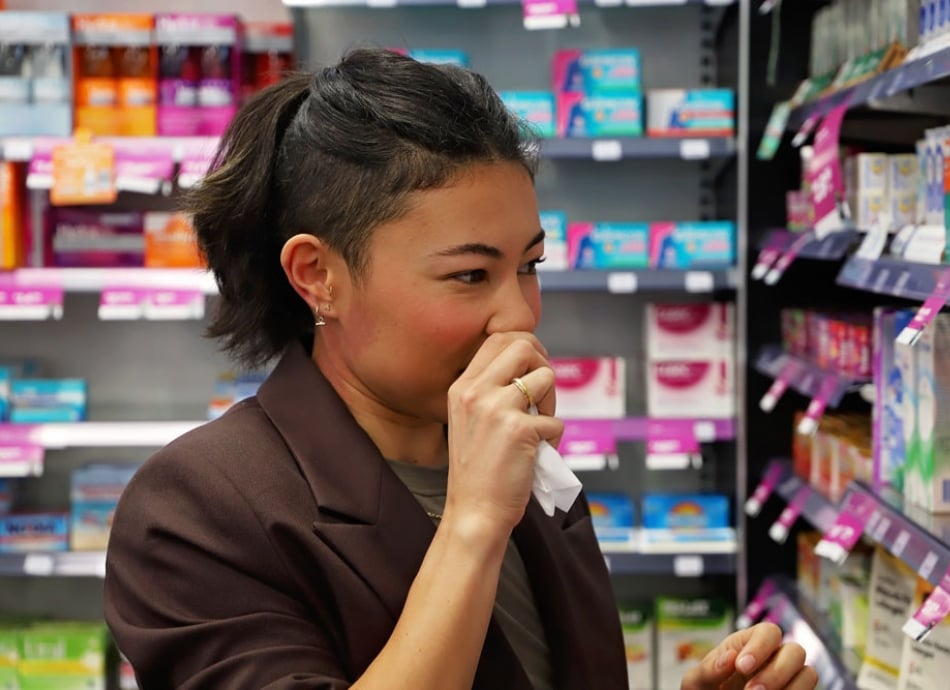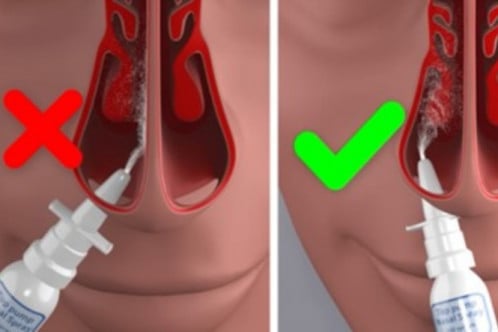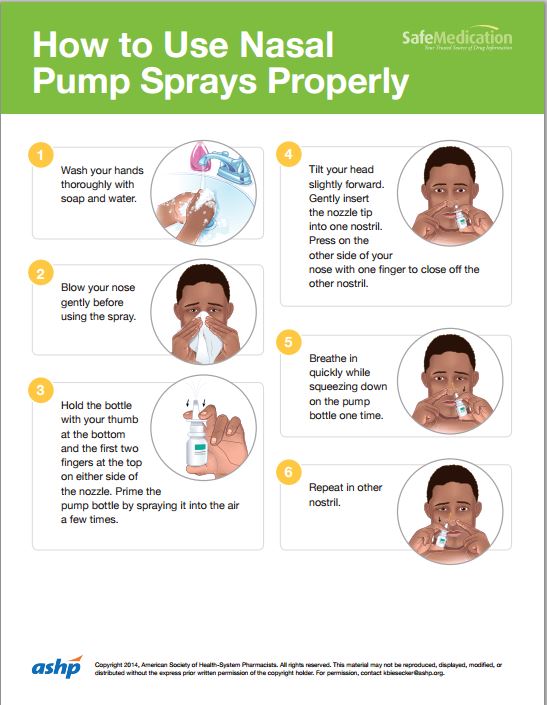Nose drops and sprays
Also called nasal drops and nasal sprays
Key points about nose drops and sprays
- Nose drops and nose sprays are used when medicine needs to work directly in your nose.
- They're commonly used to relieve stuffiness or a blocked nose caused by common colds, allergies or hay fever.
- Find out how to use them properly and safely.

Nose drops and sprays are commonly used to:
- relieve stuffiness or blocked nose caused by common colds, allergies or hay fever – read more about nasal decongestants
- unblock a nose – read more about saline (salt water) nose drops or sprays
- relieve allergic rhinitis by using antihistamine nasal sprays
- treat allergic rhinitis or nasal polyps – read more about steroid nasal sprays.
To get the most benefit, use the correct technique for nose drops. Nose drops are given by gently squeezing the bottle. This is different from how you use nasal sprays that use a pump device to deliver the medicine.
Correct technique makes sure you receive the right amount of medicine. Ask your healthcare provider to show you how to use nose drops.
Your nose needs to be upside down for the drops to reach the opening of the sinuses. The easiest way to do this is to lie down on a sofa or bed with your shoulders at the end and your head over the end.
The picture below shows the correct position to lie in for getting the medicine to where it needs to go.

Image credit: Canva
The following steps are a guide for using nose drops:
- Gently blow your nose with a tissue to clear the nostrils.
- Shake the bottle and remove cap before use.
- Get into a comfortable position lying down with your head tilted back.
- Insert the tip of the bottle over one nostril and squeeze the required number of drops into the nostril.
- Remove the bottle and sniff gently once or twice. Don’t sniff too hard because it will go past the nose to the throat and give you an unpleasant taste.
- Keep your head tilted for a few minutes.
- Try to avoid or at least wait a few minutes before blowing your nose. You want as much of the medicine to stay in the nose and sinus.
- Repeat the steps for the other nostril if required.
- Wipe the dropper with a clean tissue after each use.
- Replace the cap after each use.
If you can’t put the drops in yourself, ask somebody to help you.
To get the most benefit, use the correct technique. This makes sure you receive the right amount of medicine. Ask your healthcare provider to show you how to use your nasal spray.
The best technique for nasal sprays involves the following:
- Tilt your head forward.
- Direct the nozzle slightly away from the middle to avoid contact with the septum (the middle of the nose which separates the left and right airways in the nose). This will avoid damaging the tissue and causing nose bleeds.
The picture below shows the correct position to hold the tip of the spray in the nostril.

Image credit: ©2023 BMJ Publishing Group Ltd. From Teaching patients to use nasal sprays(external link) 2023.
The following steps are a guide to using a nasal spray:
- Shake the bottle and remove the cap before use.
- The first time you use the pump spray each day, you may have to “prime” it. Do this by squirting it a few times into the air until a fine mist comes out.
- Hold the pump spray with your index and middle fingers on each side of the bottle with your thumb on the bottom of the bottle.
- Tilt your head forward and gently put the nozzle into 1 nostril aiming the tip toward the back of your head and away from the middle of the nose.
- Close the other nostril with your other hand.
- With your mouth closed, pump one or two sprays into the nostril as advised by your healthcare provider.
- Breathe in slowly and gently as you spray.
- Remove the bottle and sniff gently once or twice. Don’t sniff too hard because it will go past the nose to the throat and give you an unpleasant taste.
- Try to avoid or at least wait a few minutes before blowing your nose. You want as much of the medicine to stay in the nose and sinus.
- Repeat the steps for the other nostril if required.
- Wipe the spray tip with a clean tissue after each use.
- Replace the cap after each use.
This is demonstrated in the video below.
Video: How to use a nasal spray
(Asthma Australia, 2021)
Using nasal sprays in children can be tricky. The following steps are a guide:
- Reassure your child that this may feel a bit uncomfortable but it won't hurt
- Wash your hands with soap and water.
- If your child is old enough, get them to gently blow their nose.
- Gently block one of your child's nostril by pushing on that side of the nose.
- Insert the spray nozzle into the other nostril, as far as is comfortable for your child.
- Have your child tilt their head slightly forwards.
- Press the pump down so that it sprays the medicine up, into the nostril.
- Repeat the steps for the other nostril if required.
- Wipe the spray tip with a clean tissue after each use.
- Replace the cap after each use.
Children may prefer using nose drops, ask your healthcare provider if there are suitable nose drops they could use instead of a nasal spray.
Before you start the treatment
- Check with your healthcare provider before using nose drops or sprays, as they're not suitable for everyone and may interact with other medicines.
- Read the printed information leaflet from inside the pack. This will tell you how to use the drops or spray and list any side-effects you may experience.
Key points to know
- Wash your hands before and after using your nose drops or spray.
- If the product is used correctly the medicine shouldn't drip down the back of your throat and you shouldn’t be able to taste the medicine.
- Don’t allow the spray tip to touch anything besides the inside of your nose. If the tip touches any other surface, it could pick up bacteria or other germs that could cause an infection in your nose.
- Don’t share your nose drops or nasal spray with anyone else. Sharing these could spread germs or infection.
- Follow the usage instructions from your doctor or the medication label. Use your nose drops or nasal spray for only as long as recommended, or else it could cause problems. For example, sprays used to relieve congestion can actually make congestion worse if they’re used for too long. Read more about nasal decongestants.
- Once they've been opened, nose drops and sprays should only be used for a certain time period. Check the label to see how long this is. It's a good idea to write the date you open the bottle on the label so you will know when to throw it away.
- If your nose hurts, if you begin to have nosebleeds, or if the inside of your nose stings, stop using the spray and talk to your healthcare provider.
The following links provide further information on nose drops and sprays. Be aware that websites from other countries may contain information that differs from New Zealand recommendations.
How to use nose drops properly(external link) Safe Medication, US
How to use nose drops(external link) Patient Info, UK
How to use nasal sprays properly(external link) Safe Medication, US
How to use nasal pump sprays properly(external link) Safe Medication, US
Resources
(external link)How to use nasal pump sprays properly(external link) Handout from Safe Medications, American Society of Health-System Pharmacists, US
5 questions to ask about your medications(external link) Health Quality and Safety Commission, NZ, 2019 English(external link), te reo Māori(external link)
References
- Nasal sprays work best when you use them correctly – here’s how(external link) Cleveland Clinic, US, 2022
Brochures

Handout from Safe Medications, American Society of Health-System Pharmacists, US

Medicines and side effects
Healthify He Puna Waiora, NZ, 2024

Health Quality and Safety Commission, NZ, 2019 English, te reo Māori
Credits: Sandra Ponen, Pharmacist, Healthify He Puna Waiora. Healthify is brought to you by Health Navigator Charitable Trust.
Reviewed by: Stephanie Yee, Pharmacist, Auckland
Last reviewed:





